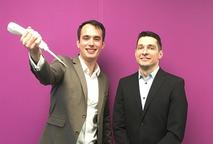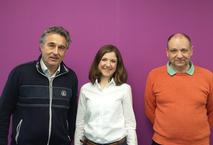Four new startups get CHF 10,000
01.02.2018
Congratulations to DispenCell, Mathrix, Resistell and Neasens who have passed Venture Kick stage 1 and each won CHF 10,000 in pre-seed funding. The teams, evolving in Biotech, Edtech, Medtech and Hightech, will move on to the 2nd stage and pitch for the CHF 20,000 prize.
 DispenCell team: Georges Muller and David Bonzon
|
 Mathrix co-founder Filipi Cabalzar
|
 Resistell team: Giovanni Dietler, Danuta Cichocka and Sandor Kasas
|
 Neasens co-founder Francesco La Torre
|
DispenCell (EPFL) BioTech
DispenCell focus on personalized medicine. To cope with long, expensive and complicated single cell isolation processes, the startup is developing a novel impedance-based technology. By using a novel pipetting systems, scientists can isolate single cells 3 times faster and 10 times cheaper than existing solutions. DispenCell wishes to introduce its robotic solution to the Biotech industry market and provide simple pipettes to the growing field of personalized medicine by selling affordable and intuitive pipettes to research labs.
Mathrix (EPFL & EdTech Collider) – EdTech
Mathrix is revolutionizing teaching with a community e-learning platform for middle and high school students. Using dynamic videos and applying new learning methods in different formats, the platform’s objective is to break formal barriers of teaching. What separates Mathrix is its social media community of 300,000+ followers on YouTube, Instagram and Snapchat that they have grown and use daily to empower students.
Resistell (EPFL) – MedTech
Antibiotic resistance is among the top medical challenge of the 21st century. Resistell introduces a new device to help reduce the speed of diagnostics of antibiotic resistance. Currently, tests require a culture of 1-2-days in order to identify the pathogen. An additional 12 to 24h are needed to conduct antibiotic sensitivity screening, with the precise timescale depending on the type of bacteria and, with some bacteria requiring up to a month. Resistell therefore proposes an alternative based on the detection of movement caused by living bacterial cells. Cantilevers, used as sensors, oscillate when in contact with living bacteria. When the antibiotic is added, bacteria react and the cantilevers’ vibrations return to the level of an abiotic sample (sample without bacteria) within minutes. Simpler and faster than commercially available solutions, the automated device allows scientists to obtain results the same day.
Neasens (formerly SmartSensors) (CERN) – Hightech/Sensors
Neasens has developed an affordable Smart IoT (Internet of things) network of sensors to detect and monitor radon, a natural radioactive gas. According to the WHO, radon is a primary cause of lung cancer worldwide for non-smokers [1]. The gas, an element in the decay chain of uranium, is naturally occurring in most soils and rocks. It easily escapes from the ground into the air and accumulates in confined spaces such as houses, schools or workplaces. Based on a novel CERN technology, Neasens created a solution that triggers automated mitigation systems reducing radon concentration indoors and therefore avoiding expensive building renovations. Its sensors monitor radon in real-time and can be easily integrated into ventilation systems and air quality controls thanks to modular electronics and software. Data collected by the network will provide the authorities with a detailed real-time map of radon dose and concentration in the country.
[1] http://www.who.int/mediacentre/factsheets/fs291/en/
DispenCell focus on personalized medicine. To cope with long, expensive and complicated single cell isolation processes, the startup is developing a novel impedance-based technology. By using a novel pipetting systems, scientists can isolate single cells 3 times faster and 10 times cheaper than existing solutions. DispenCell wishes to introduce its robotic solution to the Biotech industry market and provide simple pipettes to the growing field of personalized medicine by selling affordable and intuitive pipettes to research labs.
Mathrix (EPFL & EdTech Collider) – EdTech
Mathrix is revolutionizing teaching with a community e-learning platform for middle and high school students. Using dynamic videos and applying new learning methods in different formats, the platform’s objective is to break formal barriers of teaching. What separates Mathrix is its social media community of 300,000+ followers on YouTube, Instagram and Snapchat that they have grown and use daily to empower students.
Resistell (EPFL) – MedTech
Antibiotic resistance is among the top medical challenge of the 21st century. Resistell introduces a new device to help reduce the speed of diagnostics of antibiotic resistance. Currently, tests require a culture of 1-2-days in order to identify the pathogen. An additional 12 to 24h are needed to conduct antibiotic sensitivity screening, with the precise timescale depending on the type of bacteria and, with some bacteria requiring up to a month. Resistell therefore proposes an alternative based on the detection of movement caused by living bacterial cells. Cantilevers, used as sensors, oscillate when in contact with living bacteria. When the antibiotic is added, bacteria react and the cantilevers’ vibrations return to the level of an abiotic sample (sample without bacteria) within minutes. Simpler and faster than commercially available solutions, the automated device allows scientists to obtain results the same day.
Neasens (formerly SmartSensors) (CERN) – Hightech/Sensors
Neasens has developed an affordable Smart IoT (Internet of things) network of sensors to detect and monitor radon, a natural radioactive gas. According to the WHO, radon is a primary cause of lung cancer worldwide for non-smokers [1]. The gas, an element in the decay chain of uranium, is naturally occurring in most soils and rocks. It easily escapes from the ground into the air and accumulates in confined spaces such as houses, schools or workplaces. Based on a novel CERN technology, Neasens created a solution that triggers automated mitigation systems reducing radon concentration indoors and therefore avoiding expensive building renovations. Its sensors monitor radon in real-time and can be easily integrated into ventilation systems and air quality controls thanks to modular electronics and software. Data collected by the network will provide the authorities with a detailed real-time map of radon dose and concentration in the country.
[1] http://www.who.int/mediacentre/factsheets/fs291/en/


